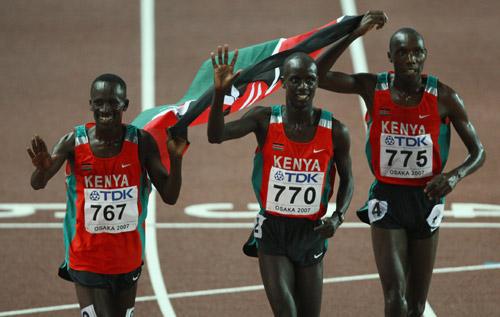Kenyan runners once again dominated the Absa Gqeberha 10K, continuing their impressive streak with another clean sweep of the podium. The annual road race, held in the coastal city of Gqeberha, showcased the remarkable endurance and speed of Kenya’s elite athletes, reaffirming their status as the world’s leading long-distance runners. This year’s event drew a large field of international competitors, but it was the Kenyan contingent that ultimately set the pace and secured all top positions, much to the delight of fans and supporters.
Kenyan Runners Dominate Absa Gqeberha 10K Podium Again
The Absa Gqeberha 10K once again proved to be a showcase of Kenyan excellence in long-distance running, as athletes from the East African nation swept the podium in both the men’s and women’s categories. Their remarkable endurance and pace dominated the race, leaving competitors from all over the continent trailing behind. The event marked another milestone in Kenya’s continued legacy in distance running, reaffirming their stronghold on international road races.
Key highlights from the race include:
- Men’s winner: 27:45 minutes
- Women’s winner: 31:08 minutes
- Top 3 finishers from Kenya secured all medals in both categories
- Course conditions: cool weather and flat terrain aided fast times
| Category | 1st Place | 2nd Place | 3rd Place |
|---|---|---|---|
| Men’s | Kenya – Daniel Kiprop | Kenya – Joseph Mwangi | Kenya – David Kamau |
| Women’s | Kenya – Grace Njeri | Kenya – Beatrice Wanjiku | Kenya – Cynthia Mutua |
Analyzing Training Techniques Behind Kenya’s Long-Distance Success
Kenyan dominance in long-distance running is no accident; it is the product of meticulously honed training techniques passed down through generations. Central to their success is high-altitude training, primarily conducted in regions such as the Rift Valley. This environment naturally boosts athletes’ lung capacity and oxygen efficiency, creating a physiological edge. Equally important is the balance between volume and intensity-daily routines often include long runs mixed with interval training to build both endurance and speed. Coaches emphasize consistency, discipline, and the importance of adaptative training schedules tailored to individual athletes, ensuring optimal performance peaks during major competitions like the Absa Gqeberha 10K.
Beyond physical preparation, Kenyan runners benefit from a strong community-centric approach that fosters competition and support simultaneously. Group runs simulate race conditions while reinforcing mental toughness. Nutrition and recovery practices, though simple, are highly effective-typically centered around local staples rich in carbohydrates and proteins, complemented by natural remedies to reduce inflammation. Below is a brief overview of key training components that distinguish Kenyan methods:
- Altitude Exposure: 2000-2500 meters above sea level
- Weekly Mileage: 120-160 km
- Training Sessions: 2-3 intense interval workouts + recovery runs
- Community Runs: Early morning group practices
- Recovery Rituals: Traditional massages, stretching, hydration with natural fluids
| Aspect | Kenyan Approach | International Contrast | ||||||||||||||
|---|---|---|---|---|---|---|---|---|---|---|---|---|---|---|---|---|
| Training Environment | High-altitude rural | Sea-level/varied locations | ||||||||||||||
| Group Dynamics | Strong community camaraderie | Often individual-focused | ||||||||||||||
| Diet | Natural, locally sourced | Supplement-heavy | ||||||||||||||
| Race Strategy | Paced with tactical surges | Purely pace-driven |
| Aspect | Kenyan Approach | International Contrast | ||||||||||||||
|---|---|---|---|---|---|---|---|---|---|---|---|---|---|---|---|---|
| Training Environment | High-altitude rural | Sea-level/varied locations | ||||||||||||||
| Group Dynamics | Strong community camaraderie | Often individual-focused | ||||||||||||||
| Diet | Natural, locally sourced | Strategies for Local Athletes to Close the Gap in Upcoming Races
| Training Focus | Details | Frequency |
|---|---|---|
| Speed Work | 400m & 800m intervals at race pace | 2x per week |
| Endurance Runs | Long runs 20-30km at moderate pace | 1x per week |
| Recovery & Mobility | Stretching, foam rolling, light jogging | 3-4x per week |
| Strength Training | Core and leg strengthening exercises | 2x per week |
- Consistent monitoring ensures training intensity matches recovery.
- Diet and hydration should be aligned with energy demands.
- Race simulation workouts to familiarize with pacing and conditions.
The Way Forward
As the dust settles on another thrilling edition of the Absa Gqeberha 10K, Kenya’s dominance on the course remains unmistakable. This clean sweep not only underscores the depth of talent within Kenyan long-distance running but also highlights the country’s continued excellence on the international stage. As athletes and fans alike look forward to next year’s race, the bar has undoubtedly been set higher, promising yet more exciting competition ahead.

